Prowly is designed to make PR outreach the easiest thing in the world. And if you’re already familiar with the concept of outreach, then you know how time-consuming it can be.
When it comes to link building; high quality, editorial links are the ones that have the biggest impact on SEO and, ultimately, where your website ranks in Google. This is why digital PR is fundamental to link building.
High-quality links come as a result of real people wanting to link to your content. As for reaching enough people to see results - that’s where Prowly comes in.
It’s one thing having an amazing piece of content or a unique set of data to offer to journos, but if you don’t have the reach - your campaign will flop. But that’s not all.
Knowing how to craft an outreach email is crucial, as is sending it to the right people in the first place. To save yourself the time and effort of going back to the drawing board, I can’t stress this enough: do your research and use link building software.
With that being said, here’s how you can use Prowly for PR link building.
- Creating the perfect media list
- Personalizing your email outreach
- Review
- Following up
- Performance reports are sexy
- OK, now go and give it a whirl
1. Creating the perfect media list
This is arguably the longest and most important, primitive step.
Consider what you want from your outreach. If you’re wanting to promote a piece of content to people who already have an interest in what it’s about (i.e. they’ve written about it or something related before), you can use Prowly’s database to quickly find people who write about a chosen topic.
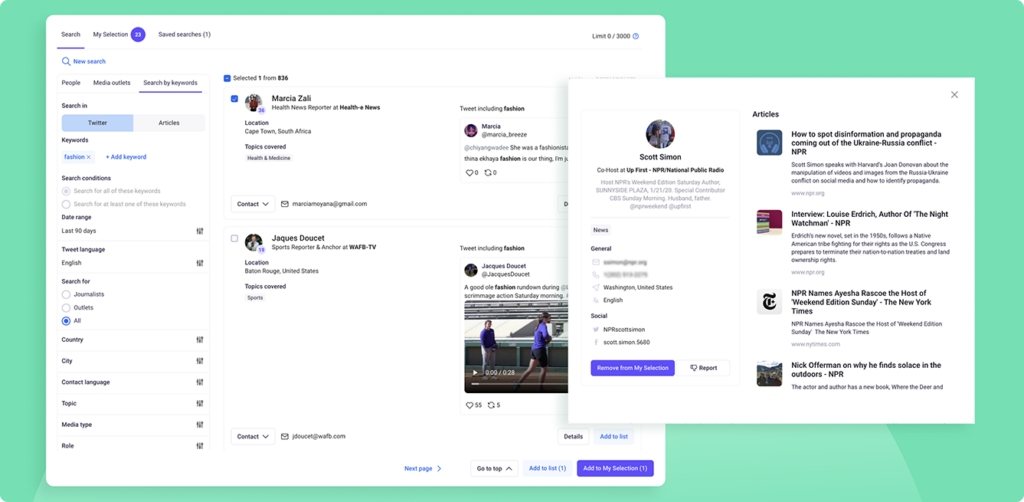
When searching for prospects it makes sense to filter the results to refine your search and prevent accidentally emailing irrelevant people (e.g. if the purpose of your outreach is link building, you’re not going to want to target journalists in print or radio).
You might also want to filter your search results by country or city if your campaign is specific to a certain location. This is particularly useful for us at Hedgehog, as an international SEO agency with clients in the UK, Brazil, Portugal, and Spain.
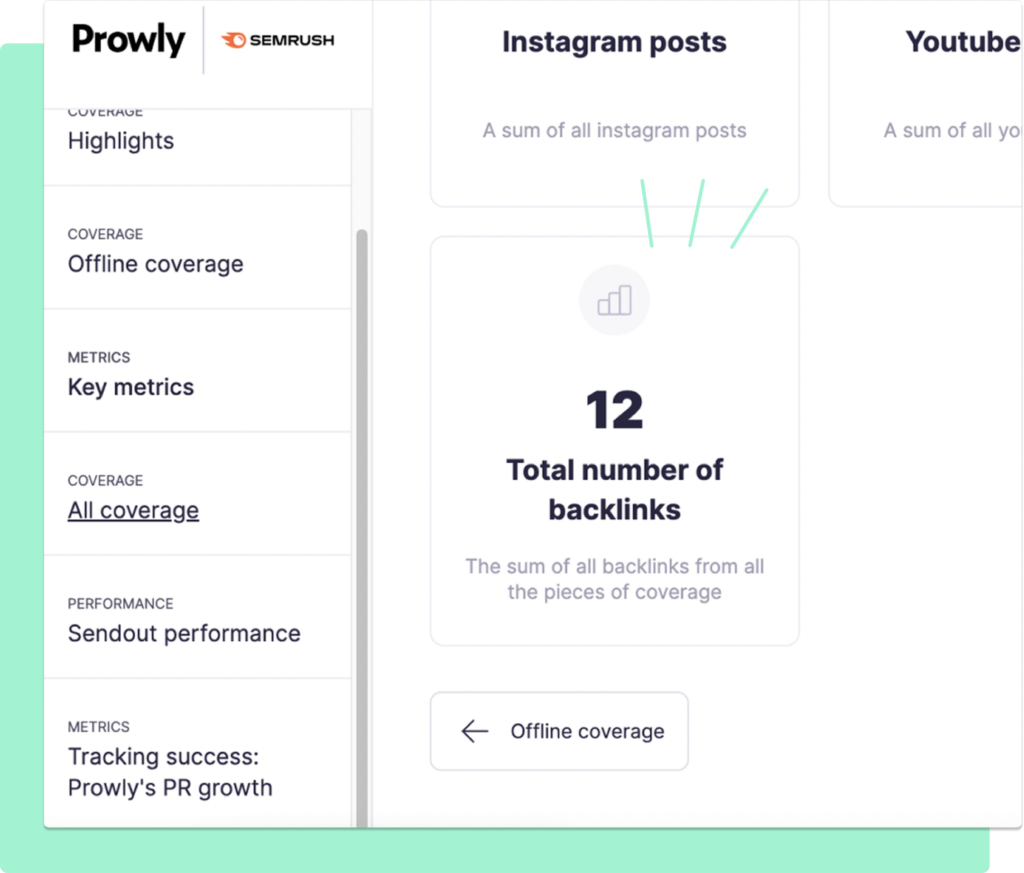
You can tell a lot about someone by their Twitter feed. When you click on a journalist or blogger’s contact card, you’ll see an option to go to their Twitter, Instagram, or LinkedIn - if that’s your thing. Trudging through Google to find people’s socials every time can prolong the process of building your media or outreach list, so this is very convenient.
You can utilize this and see if there’s anything you have in common that you can use as common ground. Bear in mind: if you go down this route, you’ll want to email them separately.
It’s also just a good way of getting a feel for what kind of person they are online. If someone tends to use exclamation marks quite generously, using humor and enthusiasm in your emails might really resonate with them.
When identifying prospect sites manually, do your absolute best to find a personal email address (hunter.io and voilanorbet.com can help you out). Only use generic email addresses or contact forms as a last resort.
Now, let’s say you want to outreach to journalists who have written about a very specific topic or subtopic in your niche and you want to reference that in your email; simply compiling a list of contacts based on the subjects they typically write about probably isn’t personal enough.
But one of the perks of Prowly is that you can track those journalists down manually and enter them into your own basic Google or Excel spreadsheet - and then import them into your contact list. It’s a nifty way of combining automation and personalization; PR link building needs to be a strategic, yet conscientious process.
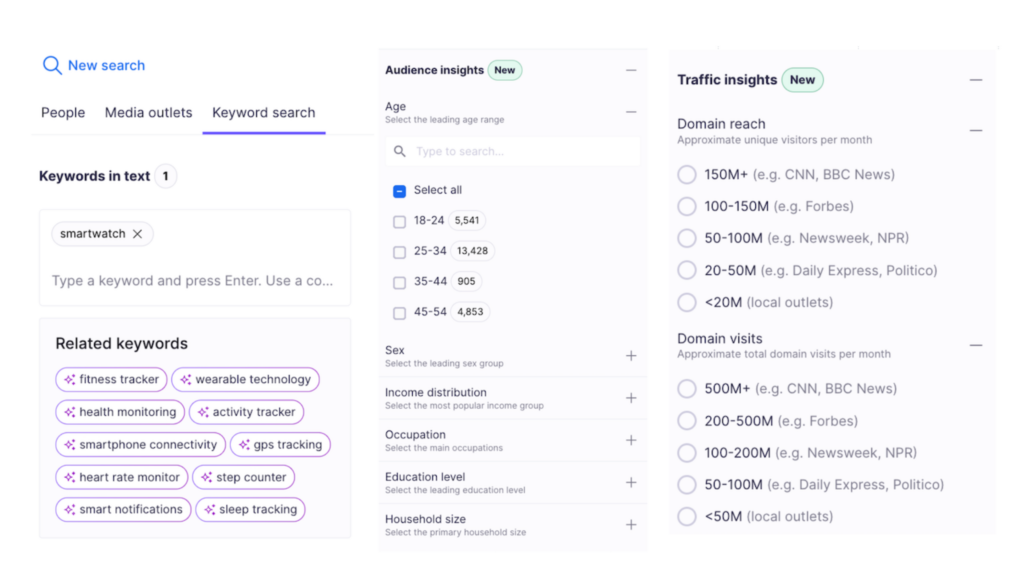
And don’t worry, you can change specific contact details such as the publication they write for, location, and so on - by clicking on their name in your contact list later on.
2. Personalizing your email outreach
A huge part of PR link building is tailoring the content of your emails to show that you’ve actually thought about your decision to reach out to the people on your list, and have looked at what sort of things they cover and what appeals to them. It’s not about throwing a load of things at a wall and seeing what sticks.
It’s about building relationships. Journalists are real people and they receive flurries of pitches and media releases every day; so you have to put the effort in. The catch with this is it can be very time-consuming - if you’re not using PR link building software.
Get into the habit of creating effective, shiny email templates, but find a way to weave your personality into it.
Generally, these are some key things to consider when creating an email template:
- Always use the first name if there is one and if not, use the personalization token feature in Prowly to set a default fallback word if a certain value isn’t available. Example: if the contact address is generic (info@businessname.com) and there is no name on file, this feature will fill in the gap.
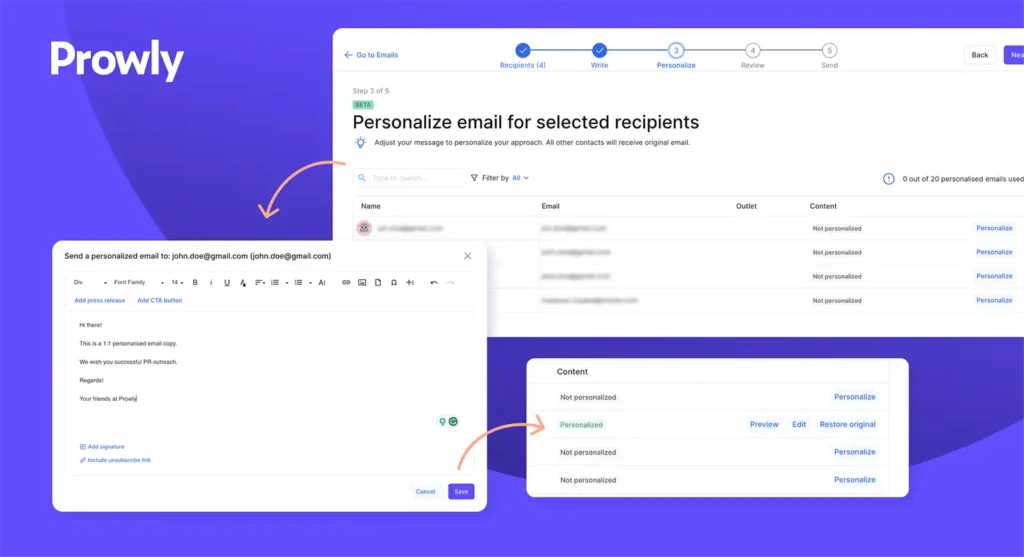
- Don’t make it all about you. Communicate in a very concise way why it would benefit their audience and opt for language that reiterates the value of your content. For example: it would be better to sign off with “Let me know if you find it useful!” rather than “Let me know if you decide to link to it in your article!”
- Stick to around roughly 6 or 7 paragraphs - and by paragraphs, I mean 1-3 sentences. If you have a few hundred words to accompany a piece of content or story, you can always embed this in the body of the email after your sign-off.
- Demonstrate some sort of understanding of what they have covered in the past (be careful to be quite broad when doing this in a template as it will be going to multiple people).
- Think long and hard about your subject line. Avoid sounding overly promotional and robotic; people are more likely to open your email if you sound relatable and human. If your content has a news angle to it, try making the subject line sound like a headline.
- Adopt an inverted pyramid structure; start with the most important points at the top of the email.
- Experiment with different templates and see what works. In Prowly you can send multiple emails within the same campaign by going to Emails > New email > Select campaign. By doing this, you can see your different strategies side by side and compare their effectiveness.
Aside from the benefit of gathering what works from testing different approaches, sending multiple emails using a variety of templates should effectively increase your conversion rate.
3. Review
Prowly’s automated review feature will give you a gentle nudge (or five) if there’s anything you’ve forgotten before you send off your email. And chances are you will forget because emails are tiresome and you’re a human being.
There’s nothing worse than making a classic, rookie error when it comes to PR link building. Forgetting to add the first name or leaving a blank where you were supposed to reference the name of a publication doesn’t look great. In fact, it could be the difference between someone reading your email and binning it.
In the Review stage, you’ll be prompted to verify recipients, remove words that might come across as spammy, add preview text to boost chances of your email being opened (compatible in some email client software) and more. These things will all help in making sure your email is as personal and as informative as possible.
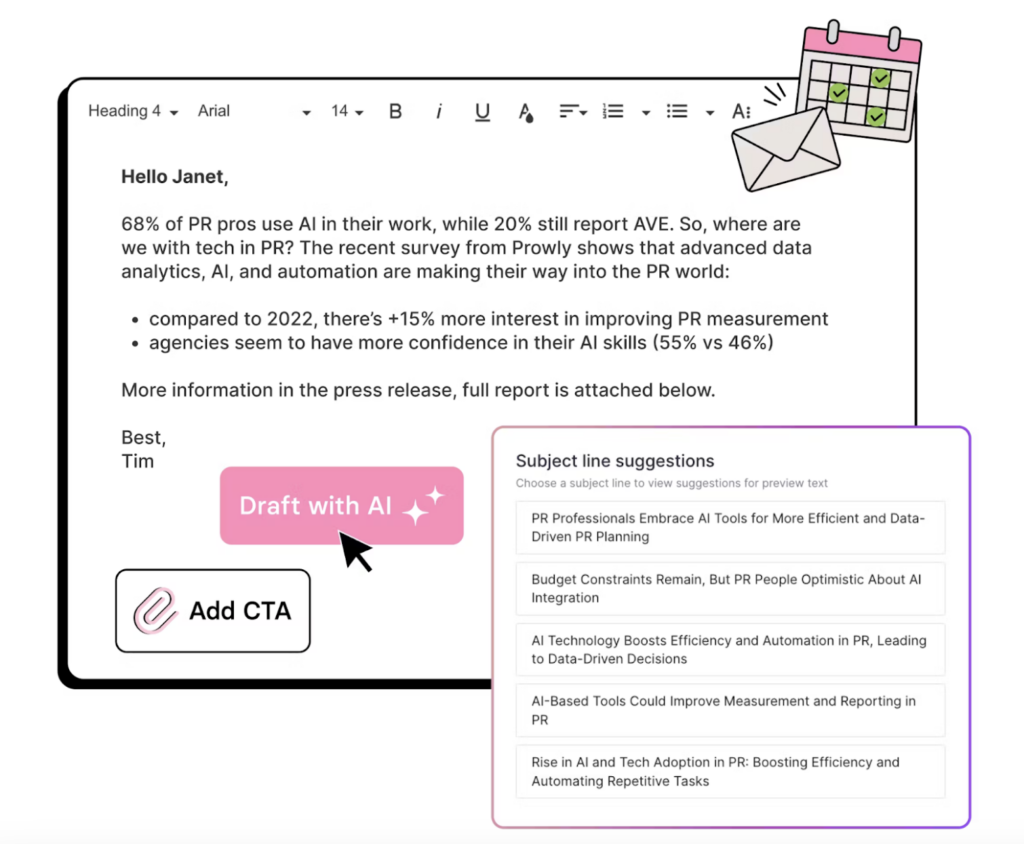
Aside from link building software, it’s also a great email marketing tool.
4. Following up
Ideally, you should only follow up once. In a perfect world, that is. Although, there have been a ton of different theories regarding this. One would reasonably assume that if someone has opened their first email and the follow-up, and not replied; they’re not interested.
But there could be a few reasons why they haven’t hit you back.
Maybe the basic gist of the email wasn’t clear; they might not have fully understood what your intentions were, or what’s in it for them. Perhaps there wasn’t a clear enough CTA. These little details can make all the difference when corresponding with busy people.
This is why you need to be meticulous in your approach to following up and make every interaction count. A follow-up can potentially make or break a collaboration or relationship, so be careful not to overdo it, and think about how you can offer more value or more information in a way that elicits a response the next time around.
Whatever your approach, you can send a mass follow-up email to multiple recipients, using a different one for different situations.
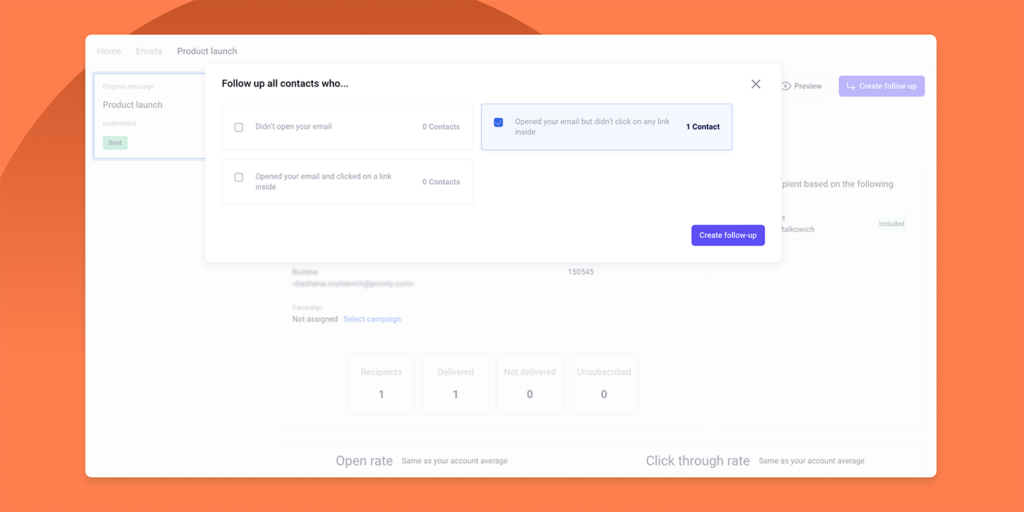
By going to Emails > [your sent email] > Followups > Detailed statistics, you can see who opened your email and who clicked on any links at a glance.
By being able to see specifically who opened your email and who clicked on a link, you’re able to tailor your email even more, because you’ll have more of an idea of what your goal ought to be.
Go to Contacts > +Add > ‘Email name,’ insert the name of the campaign, and save the filter. You’ll then be able to click on ‘Send email’ and distribute a personalized follow-up email for multiple contacts.
5. Performance reports are sexy
Here’s the exciting part. When your PR link building campaign is all packaged up and ready to go, you can send it off and wait for the performance metrics to come rolling in. We’re talking open rate, click-through rate, bounce rate… you get the idea.
And with Prowly’s extremely user-friendly interface, it’s super simple.
We want data that is easy to interpret, especially when we have other tasks to do. So if you feel like you’re not a data person, or numbers scare you, this is really easy to do.
Don’t underestimate these little numbers. They are extremely telling. Just by looking at them, you have the means to fine-tune your email outreach process because you can see quite plainly what works and what doesn’t. The proof is in the performance pudding.
Do emails with an emoji in the subject line have a higher open rate? Maybe sprinkle in a few from time to time. Maybe people respond more warmly to emails where you reference a TV series they recently tweeted about, or when you embed an infographic in the body of the email as opposed to attaching it as a file.
Responses will differ depending on the type of outreach, the person, the industry you’re targeting - all sorts of things. Outreach is equal parts trial and error, and something that needs to be refined over time.
We have prepared special guides about relevant PR metrics to follow (and ones to leave behind):
👉🏼 What is UVPM aka Domain Reach in PR? (UVPM metric alternatives)
👉🏼 What is Advertising Value Equivalency in PR? (+ AVE Alternatives)
Here are two additional metrics to follow as a PR pro, along with tips on how to efficiently accomplish them:
👉🏼 Share of Voice in PR: How to Calculate Your Brand SOV
👉🏼 Media Mentions Guide: How to Track Media Mentions Effectively
6. OK, now go and give it a whirl
Here’s the thing:
Automation is a game-changer. And the digital world is constantly evolving, so you might as well keep up. It might seem intimidating at first, but believe me when I say: if you don’t, you will learn the hard way.
When it comes to email outreach, quantity is just as important as quality. Like with a lot of things in life, balance is key, and you want all the hard work you’ve put into your campaign to pay off, so to do this and to increase chances of it getting traction, you need those numbers.
On the surface, PR tools like Prowly make some of the more tedious parts of link building a lot easier, so you’re able to distribute your time more evenly. But ultimately, they maximize your productivity which, in turn, increases your chances of getting your content to land in the right person’s lap - and generating links.

